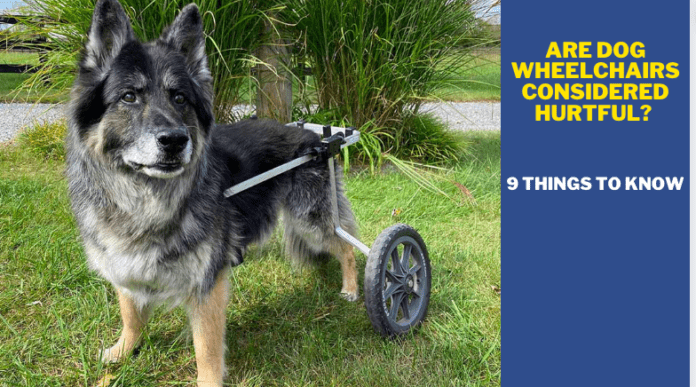Last Updated on January 12, 2022 by Dogs Vets
Are Dog Wheelchairs Considered Hurtful?
Is your dog having difficulties with its hind legs? Have you considered acquiring a dog wheelchair, but you are worried if dog wheelchairs are cruel?
I have the same worries. Our rescue Bella is a chihuahua mix. She has a lengthy body like a dachshund, and others have informed us she’ll likely have hind leg troubles in her old age. So I decided to do some digging.

Here’s what I found out.
No, dog wheelchairs are not cruel. When chosen correctly with your vet’s instruction, a dog wheelchair can extend the functional life of your dog. Plus, occasionally, dog wheelchairs are important to assist them in getting through tiny procedures or injuries.
How Long Can A Dog Stay In A Wheelchair
Dog wheelchairs are not suited for long durations. They are intended to be used for short walks.
Generally, your dog should not stay in a dog wheelchair for more than 15-60 minutes a few times a day. Utilize them to entice your dog out for toilet breaks, brief walks, and simply to enjoy the outdoors and greet other dogs.
Certain wheelchairs, such as the two-wheel type offered by Eddie’s Wheels, offer greater movement than more fixed wheelchairs. Consult your veterinarian about this.
Dogs in Wheelchairs’ Quality of Life
If your dog needs a wheelchair, it is likely that its quality of life has deteriorated significantly. Wheelchairs can help alleviate some of this by allowing them to venture outside and stroll about independently without the assistance of a back dog harness.
This enables them to do what canines enjoy. They are free to roam the yard, greet other dogs nearby, and poop and pee whenever they like.
Certain models are collapsible, allowing your dog to sit or sleep down while still in their wheelchair.
How Do dogs poop while using a Wheelchair?
Dogs are permitted to pee and boop in the majority of wheelchairs. The chairs are positioned to allow people to spread their legs and relieve themselves. Poop will fall naturally without colliding with the frame.
Eddie’s two-wheeled version even allows for back and forth tilting. This enables them to bend forwards to sniff the ground and backwards to poop and pee in a more natural manner.
Cases of Dog Abuse in Wheelchairs
I was concerned about wheelchair abuse and dug around a little.
Apart from one incident about a man in a wheelchair punching his dog, I found no evidence of people abusing their dogs as a result of their use of a dog wheelchair.
I believe the most typical “abuse,” and I use the term “lightly” if you intend to leave your dog in a wheelchair for an extended period of time.
This could result in rashes or abrasions as a result of their skin rubbing excessively against the straps and other items.
This has happened to my dog Billy as well, when we’ve walked too many miles in her little dog harness or when she’s worn a terrible collar. The webbing had creases that scraped on her skin. We just changed our harness!
With a dog wheelchair, you won’t have that option, so you’ll want to constantly monitor your dog for sores caused by prolonged use of the wheelchair and adjust accordingly.
You can tighten the straps, add strap pads to reduce irritation, or simply have them spend less time in the wheelchair in general.
Common Myths About Dog Wheelchairs and Disabled Animals

It’s More Difficult To Care For Disabled Animals…Generally, impaired animals require the same level of care as non-disabled dogs.
This is especially true if you provide them with tools to assist them in overcoming their impairments, such as a dog wheelchair.
Certain issues, such as incontinence, will require further effort on your part. The majority of disabilities are simply a matter of relearning what your dog can and cannot accomplish.
If you provide them with a safe backyard to play in, they will eventually learn to overcome their impairments and live a safe and happy life.
In A Dog Wheelchair, Dogs Cannot Get Enough Exercise
Even at recommended levels, a dog can use a wheelchair for up to an hour three times a day once he or she becomes accustomed to it.
They may not be able to run 6-7 miles per day as they once did, but they can still get out and exercise and have a happy life.
Animals with Disabilities Become More Aggressive
This is more likely to be true for dogs who are blind, deaf, or both. Dogs that require dog wheelchairs rarely grow more aggressive.
Even for dogs that develop blindness and/or deafness, this is more of an anecdotal myth than something to anticipate.
If a dog exhibits hostility, it should be addressed through effective aggression training.
If your dog was not violent prior to becoming blind or deaf, he or she is unlikely to become more aggressive after becoming blind or deaf.
If they were already violent, the fear caused by making it more difficult to see or hear anything close may increase their aggression. This is something that should have been addressed prior to the disability.
Still, it is preferable to be late than never. Some basic aggressive training may go a long way towards making your newly crippled dog happier, more confident, and less fearful of the impending change.
Dog Wheelchairs Are Ineffective For Senior Dogs
As long as your dog is not in discomfort and is able to go outdoors to relieve himself, there is no reason not to assist them with a dog wheelchair. This is particularly true for senior dogs. If they have the strength to go, providing them with a wheelchair will merely simplify the task.
Disabled Animals Require More Vet Visits and Get Sick More Frequently
As with the last question about hostility, disabled dogs are unlikely to become sicker as a result of their new disability if they did not already have health problems.
This is another widespread misconception concerning crippled dog care.
Yes, you will need to pay attention to some minor details, such as ensuring they do not develop strap sores when using their dog wheelchair. Nonetheless, you should not have to worry about your dog developing new health problems once they begin using their dog wheelchair.
Injured Dogs Who Use A Wheelchair Recover More Slowly
The majority of dogs would prefer to walk without a wheelchair than in one. Additionally, they would much prefer to go outside and walk in a wheelchair than not at all.
Animals With Disabilities Have A Poor Quality Of Life
This is largely determined by how you assist them in transitioning. Allowing them time to adjust to their new wheelchair, ensuring it is properly fastened, and ensuring they are not in discomfort, there is no reason they will not learn to use it and continue to live a happy life.
You Cannot Use A Wheelchair for Large Dogs
There are numerous wheelchairs available for dogs ranging in size from small chihuahuas to huge canines weighing over 200 pounds.
Because the older dog carts supported just soft tissue (e.g. the belly), they did not perform well with larger dogs.
The new wheelchairs are based on the skeleton of a dog. This enables them to support dogs weighing more than 200 pounds.
How Do Dogs Wheelchairs Operate?
In essence, dog wheelchairs support the hips in the case of rear leg problems, the front shoulders in the case of front leg problems or amputations, or the entire chest and spine in the case of front and back leg problems.
Your dog will propel itself forwards or backwards depending on the model. They may use a combination of their front and back legs in quad systems.
Dog Towel Test and Examination
Will your dog benefit from a dog wheelchair? To ascertain this, conduct the towel test. Simply support their rear legs with a towel under their hips and walk beside them.
Additionally, they contain back leg support belts for this purpose.
Is your dog walking more confidently now? Were they able to move more quickly? If this is the case, they may be able to use a dog wheelchair and maintain a high quality of life. Consult your veterinarian and/or borrow one from a friend to determine if a dog wheelchair is a good match.
FAQ
What is the proper term for a dog wheelchair?
While there are dog wheelchairs (also known as dog carts) for nearly every type of mobility impairment, the most common version is the two-wheel cart for dogs with rear leg issues. The severity of back leg problems can range from limited motion to full paralysis.
Are canine wheelchairs cruel?
No, canine wheelchairs are not inhumane. When used properly and under the advice of your veterinarian, a dog wheelchair can help extend your dog’s useful life. Additionally, dog wheelchairs may be necessary to assist them with minor procedures or injuries.
Will A Wheelchair Improve Your Dog’s Quality of Life?
If your dog is not in discomfort, passes the towel test, and your veterinarian agrees, then yes, a dog wheelchair will improve your dog’s life if they have issues with their rear or front legs.
When Is It Necessary For A Dog To Use A Wheelchair?
If your dog is unable to walk or move its front or back legs, and your veterinarian agrees, a wheelchair can be a very beneficial tool for improving their mobility.
Will My Dog Be Comfortable In The Wheelchair?
Probably not initially. Most dogs require some time to adjust. Your patience and training will be required.
However, your dog will eventually appreciate being able to walk more freely. They will always desire to walk without the assistance of a wheelchair, but a walking dog is happier than an immobile dog.
Will A Wheelchair Be Beneficial If Your Dog Has Degenerative Myelopathy?
It is possible. Consult your veterinarian about this. I haven’t encountered this issue with our chihuahua mix Ella yet, but we’re prepared. We’re discussing prevention strategies such as using dog ramps to help her get up and down from the bed and couch in order to avoid degenerative myelopathy.
There is no cure for degenerative myelopathy at the moment.
Will A Wheelchair Be Beneficial If Your Dog Has Hip Dysplasia?
Once more, possibly. You’ll need to consult your veterinarian. Wheelchairs have historically been used to assist dogs suffering from hip dysplasia and degenerative myelopathy.
Conclusion:
We hope you enjoyed this article…
Please feel free to share with us in the comments section below.

















